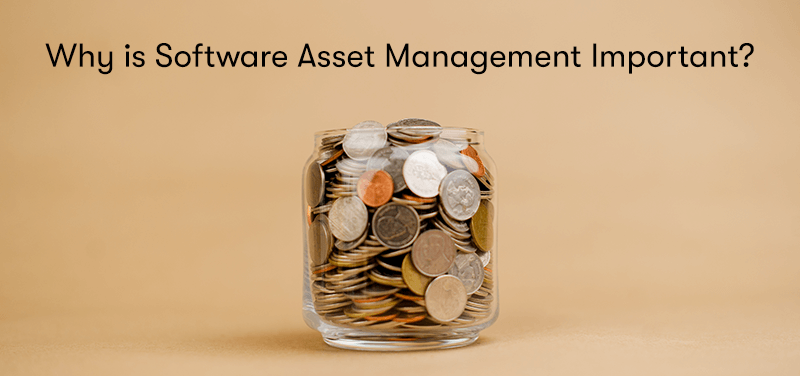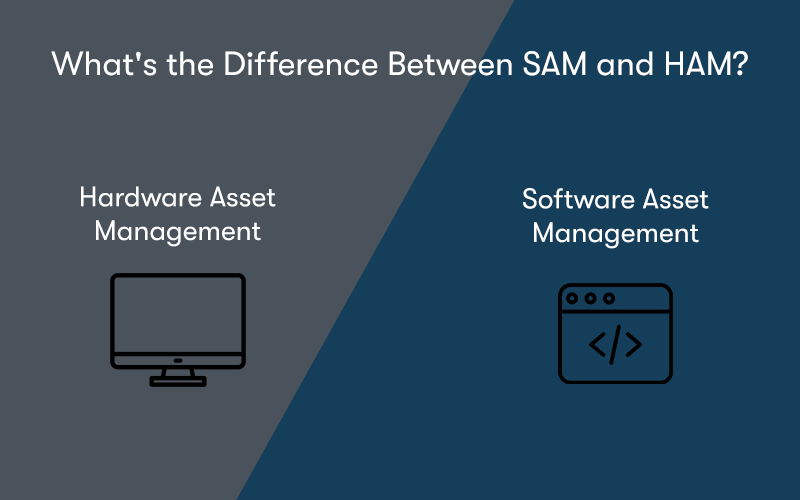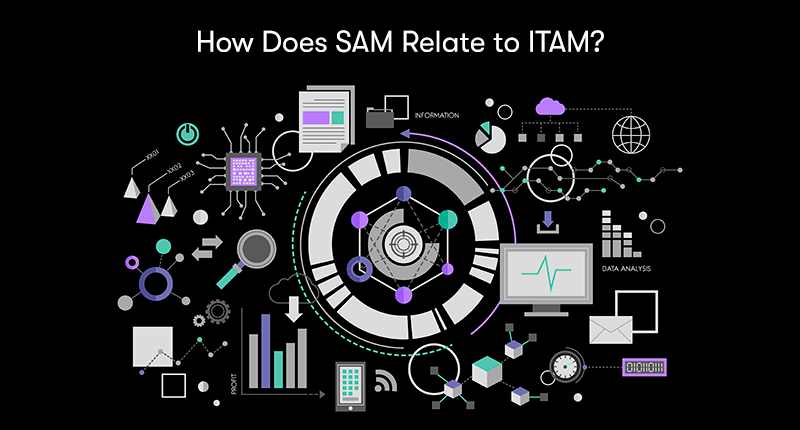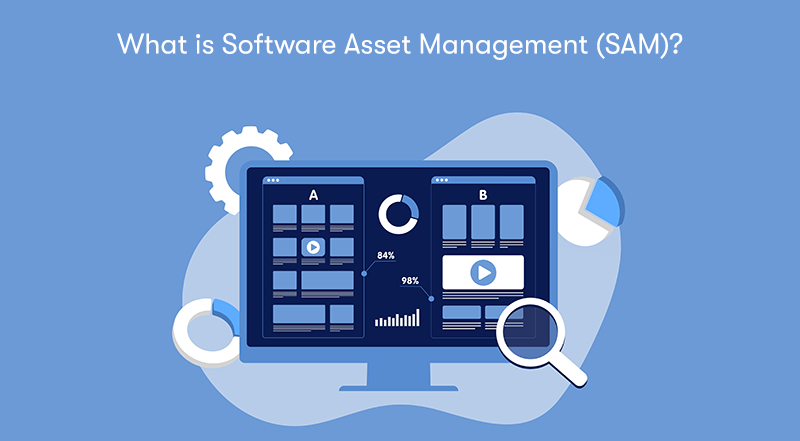What is Software Asset Management (SAM)?
Welcome to our exploration of Software Asset Management (SAM), a pivotal aspect of modern IT strategy that stands at the crossroads of technological advancement and business efficiency. In an era where software governs the pulse of business operations, understanding SAM is no longer optional but necessary for organisations seeking to thrive.
SAM, a discipline focusing on effectively managing software assets, encompasses much more than mere inventory control. It's about optimising software usage, ensuring compliance with licensing agreements, and aligning software investments with business objectives.
Through this insightful journey, we'll unravel the layers of SAM, its importance, practices, and its impact on the broader scope of IT asset management, offering a lens to view how software assets can be managed strategically to fuel business success in the digital age.
What is SAM (Software Asset Management)?
Software Asset Management (SAM) is a business practice that involves managing and optimising the purchase, deployment, maintenance, utilisation, and disposal of software applications within an organisation. The core idea behind SAM is to establish a comprehensive understanding and control over the software assets in an organisation. This process ensures that software licenses are used legally and efficiently, helping to avoid legal risks associated with under-licensed software and financial risks related to over-licensed software.
The SAM process encompasses various tasks, including the inventory of software assets, management of the software lifecycle, and ensuring compliance with software licenses. Inventorying software assets is a critical step in SAM, as it provides a baseline for understanding what software is in use, where it is installed, and whether it is being used efficiently and effectively. This inventory can help identify unused or underused software, allowing for more cost-effective management of these assets.
Lifecycle management is another crucial aspect of SAM, involving the tracking and managing of software from its purchase through its deployment, usage, upgrading, and eventual retirement. This process ensures that software is kept up-to-date and continues to meet the organisation's evolving needs.
Compliance management in SAM involves ensuring that the organisation adheres to the terms and conditions of software licenses. This can include auditing software usage, comparing it with the terms of the license agreements, and taking steps to rectify any discrepancies. This aspect of SAM helps avoid legal issues and potential fines associated with non-compliance.
Overall, SAM is a strategic practice that helps organisations manage their software assets more effectively. It involves a systematic approach to tracking, managing, and optimising the use of software, ensuring that the organisation gets the most value from its software investments while staying compliant with licensing agreements.
What Are Software Assets?

Software assets are a category of digital assets that refer to software programs and related resources an organisation uses. These assets are crucial components of an organisation's IT infrastructure and are key to its operational effectiveness. Understanding the various elements that constitute software assets can provide insight into their importance in the modern business landscape:
Software Programs/Applications
This is the most apparent component of software assets. It includes all an organisation's software applications and programs, from standard office productivity tools to specialised business applications. These can be off-the-shelf products, custom-developed software, or open-source solutions.
Software Licenses
Licenses are legal agreements that allow organisations to use software applications. They define how a software product can be used, who can use it, and how many systems it can install. Licenses can vary significantly – from individual user licenses to enterprise-wide agreements, including subscriptions and perpetual licenses.
Software Documentation
This includes user manuals, development guides, installation instructions, and other materials that support the use of software. Good documentation is essential for effectively deploying, using, and maintaining software applications.
Updates and Patches
Software assets also include updates and patches released by software providers. These are essential for fixing bugs, addressing security vulnerabilities, and adding new features to existing software applications.
Source Code
In the case of custom-developed software, the source code itself is a crucial asset. It allows the organisation to modify, update, or enhance the software according to evolving needs.
Configuration and Customisation Data
Many software applications are configured or customised to fit an organisation's specific requirements. This configuration data, which tailors the software to particular business processes or needs, is an integral part of the software asset.
Associated Digital Resources
This includes databases, middleware, and other digital tools that work in conjunction with software applications to deliver user functionality.
Software assets are vital for the operation and management of modern organisations. They represent significant investments and are integral to the efficiency and productivity of business processes. Effective management of these assets, through practices like Software Asset Management, ensures they are used legally, efficiently, and to their full potential, aligning with the organisation's strategic goals and objectives.
Why is Software Asset Management Important?

Software Asset Management is essential for several key reasons, each of which contributes to an organisation's overall efficiency, cost-effectiveness, and legal compliance. Understanding the significance of SAM involves looking at its impact on various aspects of business operations:
Cost Optimisation
SAM helps organisations avoid unnecessary expenditures on software. By keeping track of what software is owned and how it's used, companies can avoid buying redundant licenses or continuing to pay for no longer used software. SAM also enables organisations to optimise their software investments by ensuring they purchase what is needed and use what they buy effectively.
Compliance and Legal Risks
One of the primary benefits of SAM is its role in ensuring compliance with software licensing agreements. Non-compliance can lead to legal issues, including costly lawsuits and fines. SAM processes ensure that an organisation adheres to the terms of its software licenses, thus avoiding legal penalties and reputational damage.
Enhanced Security
Proper management of software assets includes regular updates and patch management, which are crucial for maintaining security. Outdated software can be vulnerable to cyber-attacks. By effectively managing software assets, organisations can reduce the risk of security breaches that stem from outdated or unpatched software.
Improved Operational Efficiency
SAM ensures that the right software tools are available to people at the right time. This optimisation of software usage improves workflow efficiency and productivity. It also helps identify and discontinue underutilised software not delivering the expected value.
Strategic Planning and Decision Making
With a clear understanding of their software assets and usage patterns, organisations can make more informed decisions regarding IT investments. SAM provides valuable data for strategic planning, ensuring that future software acquisitions align with the organisation's long-term goals.
Audit Preparedness
Regular SAM practices prepare organisations for software audits by vendors. An accurate and up-to-date inventory of software assets ensures that companies can quickly and efficiently respond to audit requests, reducing the risk of non-compliance findings and associated penalties.
Lifecycle Management
SAM involves overseeing the entire lifecycle of software assets, from acquisition to retirement. This comprehensive management approach ensures that software is kept up-to-date, appropriately maintained, and retired when no longer needed, thus maximising its value throughout its lifecycle.
In summary, SAM is a critical practice for organisations managing their software assets effectively. It not only helps reduce costs and ensure legal compliance but also plays a significant role in enhancing security, improving operational efficiency, aiding strategic decision-making, and managing the entire lifecycle of software assets.
What Are Some Best Practices for Managing Software Assets?

Managing software assets effectively is crucial for maximising their value and minimising associated risks. Here are some best practices for effective software asset management:
Maintain an Accurate Software Inventory
Keep a comprehensive and up-to-date inventory of all software assets. This inventory should include details about software versions, licenses, installations, and usage patterns. Regular audits and automated tools can help maintain this inventory accurately.
Establish Clear SAM Policies and Procedures
Develop and implement policies and procedures for purchasing, deploying, using, and retiring software. These policies should be clearly communicated to all employees and regularly reviewed for relevance and effectiveness.
Ensure License Compliance
Regularly review and manage software licenses to ensure compliance with terms and conditions. This involves understanding each software product's licensing models and restrictions and ensuring that the organisation adheres to these agreements.
Utilise Software Asset Management Tools
Employ specialised SAM tools to automate and streamline the process of tracking and managing software assets. These tools can help in inventory management and license compliance and provide insights into software usage.
Monitor Software Usage
Regularly monitor and analyse how software is being used within the organisation. This can help identify unused or underused software, enabling cost-saving opportunities such as downsizing licenses or discontinuing specific software.
Manage Software Lifecycles
Track and manage the entire lifecycle of each software asset, from acquisition to retirement. This includes staying on top of updates and upgrades, ensuring software remains secure and functional, and adequately decommissioning no longer needed software.
Educate and Train Employees
Ensure that employees are aware of SAM policies and understand the importance of software compliance. Training can prevent unintentional non-compliance and encourage efficient use of software assets.
Develop a Strategy for Cloud-Based Software
With the increasing use of cloud-based solutions, it's important to incorporate these into your SAM strategy. This includes managing subscriptions and understanding the challenges and opportunities cloud software presents.
Negotiate Software Contracts Effectively
Negotiate terms and conditions that best suit the organisation's needs when acquiring new software. Understand the flexibility, scalability, and support vendors offer to make informed decisions.
Prepare for Audits
Be audit-ready by maintaining detailed records of software purchases, deployments, and usage. Regular internal audits can help identify and address compliance issues proactively.
Integrate SAM with Other IT Processes
Ensure that SAM is not a standalone process but is integrated with other IT management processes like IT service management (ITSM) and cybersecurity.
Establish Vendor Management Practices
Develop strong relationships with software vendors for better support, understanding of products, and negotiating favourable terms.
By following these best practices, organisations can ensure they manage their software assets to maximise value, minimise risk, and support their overall business objectives.
What Are the Benefits of Software Asset Management?
Software Asset Management offers a range of benefits that can significantly impact an organisation's operational efficiency, financial health, and legal compliance. Understanding these benefits can help organisations appreciate the value of implementing a robust SAM strategy:
Cost Savings and Optimisation
SAM helps identify and eliminate unnecessary software expenses, such as unused licenses or subscriptions. Organisations can make more informed purchasing decisions by understanding actual software needs and usage, avoiding over-licensing and under-utilisation.
Enhanced Compliance and Reduced Legal Risk
One of the primary benefits of SAM is ensuring compliance with software licensing agreements. Non-compliance can result in hefty fines and legal issues. SAM reduces this risk by maintaining accurate records of software licenses and usage, ensuring adherence to the terms and conditions of software agreements.
Improved Security
Regularly updating software and maintaining compliance with licenses through SAM helps mitigate security risks. Outdated software can be a target for cyber threats, and SAM ensures that all software assets are current with the latest security patches and updates.
Increased Operational Efficiency
Having the right software tools available and in good working order is essential for operational efficiency. SAM ensures that software assets are adequately maintained and effectively deployed, which can enhance overall productivity.
Strategic Decision Making
SAM provides valuable data and insights about software usage and needs within the organisation. This information can be leveraged for strategic IT planning, helping make informed decisions about future software investments and technology strategies.
Audit Preparedness
SAM prepares organisations for software audits through accurate tracking and management of software assets. Being audit-ready can save time and resources and prevent the financial and reputational damage that can result from audit failures.
Lifecycle Management
SAM involves managing the entire lifecycle of software assets, from acquisition to retirement. This comprehensive approach ensures that software is effectively utilised throughout its lifecycle, maximising its value and efficiency.
Enhanced Visibility and Control
With SAM, organisations gain better visibility and control over their software assets. This transparency is crucial for managing IT resources, budgeting, and planning.
Support for Cloud and Virtual Environments
In today's cloud-centric world, SAM helps manage cloud-based software and virtualised environments more effectively, ensuring these assets are just as well managed as on-premises software.
Environmental Benefits
By optimising software use and reducing the need for physical resources, SAM can also contribute to an organisation's sustainability efforts.
In summary, Software Asset Management is a critical component of modern IT management. It helps organisations save costs and reduce risks, enhances operational efficiency, supports strategic planning, and ensures a high level of security and compliance in the rapidly evolving digital landscape.
What is the Purpose and Goal of SAM?

The purpose and goal of Software Asset Management encompass a multifaceted approach aimed at optimising the use and management of software within an organisation. SAM is not just about compliance or cost-saving; it's a strategic business practice that supports several key organisational objectives:
Ensuring Compliance
A primary goal of SAM is to ensure that all software an organisation uses complies with licensing agreements. This means having the correct number of licenses for the software being used and adhering to the terms set by the software vendors. Compliance reduces legal risks associated with software licensing, such as fines and legal actions due to non-compliance.
Cost Optimisation
SAM helps identify and eliminate unnecessary software expenditures. This includes avoiding over-licensing, where an organisation pays for more licenses than it needs, and under-utilisation, where software is not used to its full potential. The goal is to achieve an optimal balance of software investments that align with the organisation's actual needs.
Operational Efficiency
Efficient management of software assets ensures that the right tools are available to the right users at the right time. SAM aims to enhance productivity and operational efficiency by effectively deploying and utilising software assets.
Risk Management
Beyond legal risks, SAM also addresses other types of risks, including security risks. By managing software lifecycles effectively, including regular updates and patches, SAM reduces vulnerabilities and helps protect against security threats.
Strategic Planning and Support
SAM provides critical insights into software usage and requirements, supporting strategic IT planning and decision-making. This involves aligning software investments with the organisation's long-term goals and technology strategies.
Supporting Business Continuity
By ensuring software is up-to-date and compliant, SAM plays a role in maintaining business continuity. It helps avoid disruptions caused by software failures, audits, or compliance issues.
Lifecycle Management
SAM's key goal is to manage the entire lifecycle of software assets, from procurement to retirement. This includes optimising the use of software throughout its lifecycle and ensuring that it is retired or replaced in a timely and secure manner.
Enhancing IT Governance
SAM contributes to better governance in the IT domain by providing a framework for controlling and managing IT resources and aligning IT operations with business policies and regulations.
In summary, the purpose and goal of SAM are to establish a comprehensive and practical approach to managing software assets, ensuring they are used and maintained in a way that supports organisational objectives, reduces risks, optimises costs, and enhances overall operational efficiency. This strategic management of software assets is integral to an organisation's broader IT management and business strategy.
What Are Common Examples of Software Assets?
Software assets encompass a wide range of digital products and resources used in an organisation's operations. Common examples of software assets include:
- Operating Systems: These are foundational software that manage computer hardware and provide essential functions for other software. Examples include Microsoft Windows, macOS, and Linux distributions.
- Productivity Software: This category includes applications designed to increase individual or organisational productivity, such as Microsoft Office Suite (Word, Excel, PowerPoint), Google Workspace (Docs, Sheets, Slides), and email clients like Microsoft Outlook.
- Enterprise Resource Planning (ERP) Systems: ERP systems integrate various business processes, such as finance, HR, manufacturing, and supply chain management, into a single system. Examples include SAP ERP, Oracle ERP Cloud, and Microsoft Dynamics.
- Customer Relationship Management (CRM) Software: CRM systems help manage a company's interactions with current and potential customers. Salesforce, Microsoft Dynamics CRM, and HubSpot are popular examples.
- Database Management Software: These are systems used to create, manage, and manipulate databases. Examples include Oracle Database, Microsoft SQL Server, and MySQL.
- Content Management Systems (CMS): CMSs manage digital content, particularly for websites and e-commerce platforms. WordPress, Drupal, and Joomla are common examples.
- Cybersecurity Software: This category includes antivirus, firewall, intrusion detection systems, and other security applications designed to protect IT infrastructure. Examples are Norton Antivirus, McAfee, and Kaspersky.
- Development Tools: Software used for coding, building, testing, and maintaining applications, like Integrated Development Environments (IDEs) such as Visual Studio, Eclipse, and code repositories like GitHub.
- Business Intelligence (BI) Tools: These tools analyse business data to aid decision-making. Examples include Tableau, Microsoft Power BI, and SAS Business Intelligence.
- Collaboration Tools: Software that facilitates teamwork and communication, like Slack, Microsoft Teams, and Zoom.
- Graphics and Design Software: Applications for graphic design, video editing, and digital art, such as Adobe Photoshop, Illustrator, and Autodesk AutoCAD.
- Industry-specific Applications: Software tailored to specific industry needs, like AutoCAD for engineering and architectural design or Epic Systems for healthcare management.
- Cloud-based Services and Applications: Software offered as a service over the internet, like Salesforce (CRM), AWS (cloud computing services), and Google Cloud Platform.
- Utility Software: These applications provide system support and maintenance, like disk clean-up tools, file managers, and backup software.
These diverse software assets play critical roles in modern organisations' day-to-day operations and strategic initiatives. Managing them effectively is crucial for maintaining operational efficiency, compliance, and competitive advantage.
What's the Difference Between SAM and HAM?

Software Asset Management (SAM) and Hardware Asset Management (HAM) are two distinct but related disciplines within the broader realm of IT asset management. Understanding their differences is crucial in appreciating how each contributes to effectively managing an organisation's IT resources.
Focus of Management
SAM (Software Asset Management) focuses on the management of software assets. This includes tracking and managing the use, deployment, maintenance, and disposal of software applications and licenses within an organisation.
HAM (Hardware Asset Management), on the other hand, deals with the physical components of a computer network, such as servers, desktops, laptops, networking equipment, and other IT-related hardware.
Objectives and Goals
The primary goal of SAM is to ensure that all software within an organisation is licensed correctly, efficiently used, and compliant with licensing agreements. It also seeks to optimise software investment and minimise software procurement and usage risks.
HAM aims to optimise the physical IT infrastructure by ensuring that hardware assets are efficiently utilised, maintained, and eventually retired or disposed of in a cost-effective and environmentally friendly manner.
Lifecycle Management
SAM oversees the entire software lifecycle, including acquisition, deployment, maintenance, compliance, and retirement.
HAM encompasses the tracking and managing of the hardware lifecycle, from procurement and deployment to maintenance, upgrading, and eventual disposal.
Compliance and Legal Aspects
SAM's significant focus is on compliance with software licensing laws and regulations to avoid legal risks such as fines and litigation.
HAM, while less burdened by legal compliance issues than SAM, still requires adherence to warranties, leasing agreements, and proper disposal practices per environmental regulations.
Cost Management
SAM helps organisations avoid over- or under-purchasing software licenses and maintain cost efficiency in software utilisation.
HAM involves managing the physical assets to ensure cost-effective usage, reducing unnecessary expenditures on hardware maintenance, and optimising the timing of hardware upgrades and replacements.
Tools and Processes
SAM uses specialised tools for inventory management, license compliance, software usage, and deployment monitoring.
HAM utilises inventory management systems, tracking tools for physical assets, and maintenance scheduling software.
Security Concerns
In SAM, security concerns revolve around ensuring software is up-to-date and not vulnerable to security threats.
HAM addresses security from a physical standpoint, including the secure disposal of hardware to prevent data theft.
Both SAM and HAM are critical for the overall health of an organisation's IT infrastructure. While they focus on different types of assets, they share the common goal of optimising asset use, ensuring compliance, and contributing to the cost-effectiveness and efficiency of the organisation's IT operations. In many cases, the best practice is integrating SAM and HAM strategies for a comprehensive approach to IT asset management.
What is ISO 19770 Concerning SAM?
ISO/IEC 19770 is a series of international standards concerning Software Asset Management developed by the International Organisation for Standardisation (ISO) and the International Electrotechnical Commission (IEC). These standards provide a framework for organisations to manage their software assets effectively, ensuring they are used and worked in a way that meets compliance requirements, optimises costs, and aligns with the broader IT and business objectives. The ISO/IEC 19770 series includes several parts, each addressing different aspects of SAM:
ISO/IEC 19770-1
This is the core part of the standard, providing a framework for SAM that organisations can use to develop, implement, and maintain effective software asset management. ISO/IEC 19770-1 specifies processes and procedures organisations should follow to manage their software assets effectively. This includes guidelines for establishing a SAM system, processes for managing software inventory, compliance, and lifecycle, and guidance for continuous improvement in SAM practices.
ISO/IEC 19770-2
This standard deals with software identification tags (SWID tags). SWID tags are designed to provide a unique identifier for software products, which helps accurately and efficiently identify and manage software assets. ISO/IEC 19770-2 specifies these tags' format and data elements, making it easier for organisations to track and manage software throughout its lifecycle.
ISO/IEC 19770-3
This standard relates to the entitlement schema, which is about managing the rights associated with using software (such as licenses, subscriptions, and entitlements). ISO/IEC 19770-3 provides a structured approach for organisations to understand and document their rights and obligations concerning software, aiding in compliance management and optimising software licensing costs.
ISO/IEC 19770-4
Focused on Resource Utilisation Measurement, this part of the standard helps organisations monitor software use. It provides guidelines for collecting, managing, and reporting software usage data, critical for optimising software deployment and usage.
ISO/IEC 19770-5
This part provides an overview of IT asset management, offering guidance on best practices and the benefits of implementing an ITAM system, including SAM and Hardware Asset Management.
The ISO/IEC 19770 standards are valuable for organisations of all sizes and types, as they provide a comprehensive and universally recognised set of best practices for managing software assets. Adopting these standards can help organisations reduce costs, improve operational efficiency, enhance compliance, and make more informed decisions regarding their software assets.
How Does SAM Relate to ITAM?

Software Asset Management is a critical component of Information Technology Asset Management and is essential for effectively managing an organisation's IT resources. Understanding how SAM relates to ITAM involves examining the roles, objectives, and scope of each practice:
Scope and Focus
Software Asset Management focuses explicitly on managing an organisation's software assets. This includes overseeing software licenses, ensuring compliance with licensing agreements, optimising software usage and costs, and managing the software lifecycle from acquisition to retirement.
ITAM, on the other hand, encompasses a broader range of IT assets, including hardware (such as servers, computers, and networking equipment) and software. ITAM is concerned with the overall strategy for managing, monitoring, and optimising every aspect of an organisation's IT assets.
Integral Relationship
SAM is a subset of ITAM. While ITAM covers all technology assets, SAM focuses explicitly on the software component. The practices and strategies in SAM are integral to the broader objectives of ITAM, which seeks to optimise the value and manage the risks associated with all IT assets.
Effective ITAM can only be achieved with a robust SAM practice. Since software and hardware are deeply interconnected in any IT infrastructure, managing one effectively requires an understanding and management of the other.
Objectives and Goals
Both SAM and ITAM aim to optimise the use of IT assets, reduce costs, ensure compliance with relevant laws and regulations, and support the organisation's strategic objectives. However, SAM specifically targets these goals concerning software, whereas ITAM addresses them across all IT resources.
Risk Management
SAM helps mitigate risks related to software compliance, licensing disputes, and cybersecurity vulnerabilities due to outdated or unsupported software.
ITAM, while encompassing these aspects, also deals with risks associated with hardware, like lifecycle management, disposal of assets in a secure and environmentally friendly way, and optimising hardware investments.
Contribution to Business Strategy
SAM and ITAM contribute to the overall business strategy by ensuring that IT assets align with business goals, thereby supporting operational efficiency, financial management, and strategic decision-making.
Tools and Processes
While SAM and ITAM may utilise overlapping tools and processes for inventory management, tracking, and reporting, SAM tools are specifically designed to manage software licenses, compliance, and usage. ITAM tools, in contrast, provide a more comprehensive view of all IT assets.
In summary, SAM is an essential part of ITAM, focusing specifically on software assets, while ITAM provides a holistic approach to managing all IT resources. Effective ITAM requires robust SAM practices, as managing software assets is critical to the overall performance and compliance of the IT infrastructure. The integration of SAM within ITAM ensures that an organisation can fully leverage its IT investments to support business objectives.
Final Notes on Software Asset Management
In conclusion, this comprehensive exploration of Software Asset Management has illuminated its critical role within the broader spectrum of Information Technology Asset Management. We've delved into the nuances of SAM, differentiating it from Hardware Asset Management, and underscored its importance in optimising software investments, ensuring compliance, and enhancing operational efficiency.
Furthermore, we've examined the ISO/IEC 19770 standards, which provide a structured framework for effective SAM. By integrating SAM into ITAM, organisations can strategically manage their IT resources, mitigate risks, and align IT assets with their overall business goals.
This blog has offered valuable insights for businesses looking to refine their IT asset management strategies, ensuring a balanced and comprehensive approach to managing software and hardware assets in today's dynamic digital landscape.


